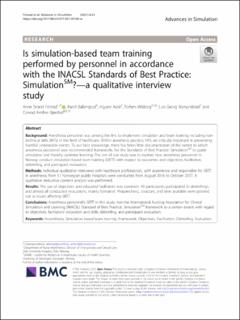| dc.contributor.author | Finstad, Anne Strand | |
| dc.contributor.author | Ballangrud, Randi | |
| dc.contributor.author | Aase, Ingunn | |
| dc.contributor.author | Wisborg, Torben | |
| dc.contributor.author | Romundstad, Luis Georg | |
| dc.contributor.author | Bjørshol, Conrad Arnfinn | |
| dc.date.accessioned | 2021-10-04T09:00:40Z | |
| dc.date.available | 2021-10-04T09:00:40Z | |
| dc.date.created | 2021-09-30T12:18:13Z | |
| dc.date.issued | 2021 | |
| dc.identifier.citation | Advances in Simulation. 2021, 6, 1-10. | en_US |
| dc.identifier.issn | 2059-0628 | |
| dc.identifier.uri | https://hdl.handle.net/11250/2787394 | |
| dc.description.abstract | Background
Anesthesia personnel was among the first to implement simulation and team training including non-technical skills (NTS) in the field of healthcare. Within anesthesia practice, NTS are critically important in preventing harmful undesirable events. To our best knowledge, there has been little documentation of the extent to which anesthesia personnel uses recommended frameworks like the Standards of Best Practice: SimulationSM to guide simulation and thereby optimize learning. The aim of our study was to explore how anesthesia personnel in Norway conduct simulation-based team training (SBTT) with respect to outcomes and objectives, facilitation, debriefing, and participant evaluation.
Methods
Individual qualitative interviews with healthcare professionals, with experience and responsible for SBTT in anesthesia, from 51 Norwegian public hospitals were conducted from August 2016 to October 2017. A qualitative deductive content analysis was performed.
Results
The use of objectives and educated facilitators was common. All participants participated in debriefings, and almost all conducted evaluations, mainly formative. Preparedness, structure, and time available were pointed out as issues affecting SBTT.
Conclusions
Anesthesia personnel’s SBTT in this study met the International Nursing Association for Clinical Simulation and Learning (INACSL) Standard of Best Practice: SimulationSM framework to a certain extent with regard to objectives, facilitators’ education and skills, debriefing, and participant evaluation. | en_US |
| dc.language.iso | eng | en_US |
| dc.publisher | BioMed Central Ltd. | en_US |
| dc.rights | Navngivelse 4.0 Internasjonal | * |
| dc.rights.uri | http://creativecommons.org/licenses/by/4.0/deed.no | * |
| dc.title | Is simulation-based team training performed by personnel in accordance with the INACSL Standards of Best Practice: SimulationSM?—a qualitative interview study | en_US |
| dc.type | Peer reviewed | en_US |
| dc.type | Journal article | en_US |
| dc.description.version | publishedVersion | en_US |
| dc.source.pagenumber | 1-10 | en_US |
| dc.source.volume | 6 | en_US |
| dc.source.journal | Advances in Simulation | en_US |
| dc.identifier.doi | 10.1186/s41077-021-00186-w | |
| dc.identifier.cristin | 1941293 | |
| dc.relation.project | SHARE - Centre for Resilience in Healthcare: 5091 | en_US |
| cristin.ispublished | true | |
| cristin.fulltext | original | |
| cristin.qualitycode | 1 | |

